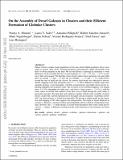On the assembly of dwarf galaxies in clusters and their efficient formation of globular clusters
Author(s)
Mistani, Pouria A.; Sales, Laura V.; Pillepich, Annalisa; Sanchez-Janssen, Rubén; Nelson, Dylan; Rodriguez-Gomez, Vicente; Hernquist, Lars; Vogelsberger, Mark; Torrey, Paul A.; ... Show more Show less
DownloadOn the assembly of dwarf.pdf (5.244Mb)
OPEN_ACCESS_POLICY
Open Access Policy
Creative Commons Attribution-Noncommercial-Share Alike
Terms of use
Metadata
Show full item recordAbstract
Galaxy clusters contain a large population of low-mass dwarf elliptical galaxies whose exact origin is unclear: their colours, structural properties and kinematics differ substantially from those of dwarf irregulars in the field. We use the Illustris cosmological simulation to study differences in the assembly histories of dwarf galaxies (3 × 10⁸ < M*/M⊙ < 10¹⁰) according to their environment. We find that cluster dwarfs achieve their maximum total and stellar mass on average ∼8 and ∼4.5 Gyr ago (or redshifts z = 1.0 and 0.4, respectively), around the time of infall into the clusters. In contrast, field dwarfs not subjected to environmental stripping reach their maximum mass at z = 0. These different assembly trajectories naturally produce a colour bimodality, with blue isolated dwarfs and redder cluster dwarfs exhibiting negligible star formation today. The cessation of star formation happens over median times 3.5–5 Gyr depending on stellar mass, and shows a large scatter (∼1–8 Gyr), with the lower values associated with starburst events that occur at infall through the virial radius or pericentric passages. We argue that such starbursts together with the early assembly of cluster dwarfs can provide a natural explanation for the higher specific frequency of globular clusters (GCs) in cluster dwarfs, as found observationally. We present a simple model for the formation and stripping of GCs that supports this interpretation. The origin of dwarf ellipticals in clusters is, therefore, consistent with an environmentally driven evolution of field dwarf irregulars. However, the z = 0 field analogues of cluster dwarf progenitors have today stellar masses a factor of ∼3 larger – a difference arising from the early truncation of star formation in cluster dwarfs.
Date issued
2015-11Department
Massachusetts Institute of Technology. Department of Physics; MIT Kavli Institute for Astrophysics and Space ResearchJournal
Monthly Notices of the Royal Astronomical Society
Publisher
Oxford University Press
Citation
Mistani, Pouria A.; Sales, Laura V.; Pillepich, Annalisa; Sanchez-Janssen, Rubén; Vogelsberger, Mark et al. "On the assembly of dwarf galaxies in clusters and their efficient formation of globular clusters." Monthly Notices of the Royal Astronomical Society 455, no. 3 (January 2016): 2323–2336.
Version: Author's final manuscript
ISSN
0035-8711
1365-2966